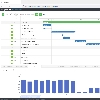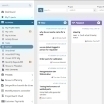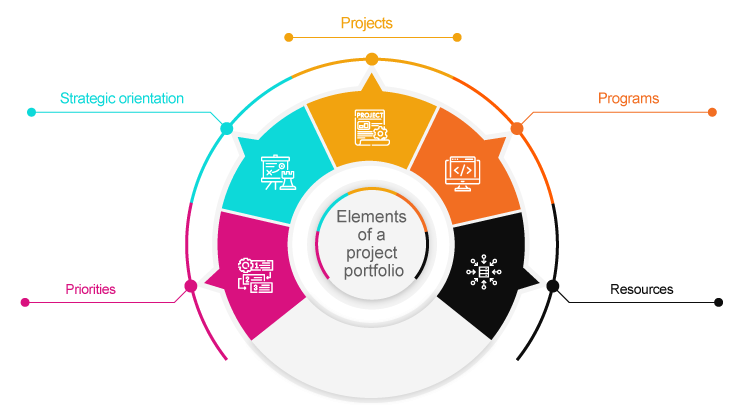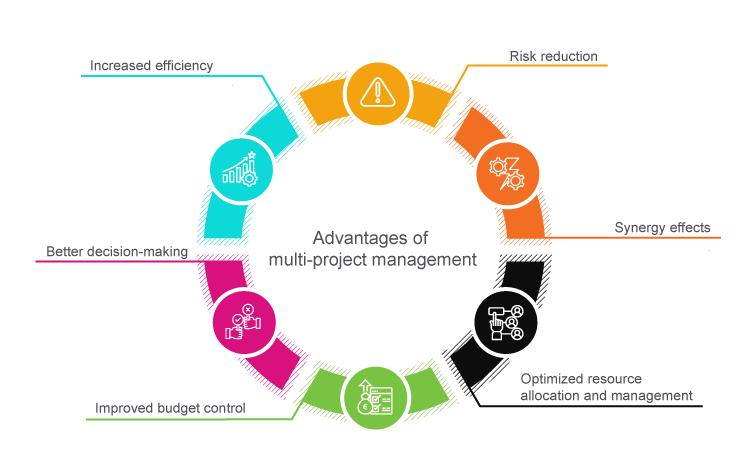Software Tips
What is multi-project management?
Multi-project management (also known as project portfolio management) involves the coordinated management and control of several projects within an organization, company or unit. Multi-project management is also used to make decisions about whether a new or additional project fits into the current or future portfolio. It is a method of ensuring that all projects are carried out effectively and efficiently and provides a holistic view of an organization's project landscape. Multi-project management can be divided into program management and project portfolio management. Program management involves several projects in programs that have a common goal. Projects in portfolios are usually separate from each other and often compete for resources.
Difference between multi-project management and project management
The main difference between multi-project management and project management lies in their scope of application and in the priorities set in each case.
Project management
Project management focuses on the planning, implementation and monitoring of a single project. By definition, a project is a time-limited undertaking that has a starting point and a specific end point. In project management, a dedicated project team works on the realization of the project goals. The resources, including employees, budget and time, are usually focused on this specific project. Success in project management is measured by whether the defined project goal has been achieved.
Multi-project management
Multi-project management deals with the coordinated management and control of several projects and considers the totality of all projects that are carried out in parallel or in succession. Multi-project management offers a holistic view of an organization's project landscape. It prioritizes, monitors and controls projects in accordance with the organizational goals. Among other things, multi-project management should ensure that resources are optimally distributed across all projects and that potential risks to projects are taken into account so that any risks that arise can be responded to.
Possible applications of multi-project management
Large organizations use multi-project management to coordinate a large number of projects in different departments or business units. In the construction industry, multi-project management methods can be used to efficiently plan and execute construction projects. IT departments use multi-project management to work simultaneously on multiple IT projects such as software development, IT systems implementation and network enhancements. In research and development departments, multi-project management techniques can help to coordinate innovation projects and product developments. Consulting companies use multi-project management to manage different client projects simultaneously and ensure that resources are used optimally.
Tips and question suggestions
Further specific criteria and question suggestions for the evaluation of software for multi-project management
- Check whether the software can be integrated with other tools and systems in your organization, e.g. calendar, email or CRM.
- Is there a mobile app or support for mobile devices? This is important when team members need to access project information on the go.
- Clarify how the security of the data is guaranteed. Ask about the software's security functions and data protection measures, especially if sensitive data is being processed.
- Can the multi-project management software manage different projects simultaneously? Does it support the creation and tracking of a project portfolio?
- Can the software effectively manage different types of projects (e.g. IT projects, marketing projects)?
- Does the software offer functions for prioritizing projects?
- How can multi-project management software help to avoid costly misinvestments in projects and maximize the efficiency of limited company resources?
- Can you use the multi-project management software to identify and resolve resource bottlenecks? Ask what resource planning and allocation tools the software includes.
- Does the software enable budget planning and tracking? Are there functions for cost analysis and control?
- What reporting and analysis functions does the multi-project management software offer? How can performance indicators and progress reports be generated to effectively monitor the project status?
- How flexible is the user interface? Can the software be adapted to individual requirements in order to map our specific work processes?
- Does the software support an agile project management methodology, such as Scrum or Kanban? Can we integrate our preferred project management approaches?
- How is training and support provided for your multi-project management tool? Are there training materials or live support to ensure our team can use the software effectively?
- Are there automatic notifications and reminders in the software to inform team members about tasks and deadlines?
- What opportunities for collaboration and communication does the software offer? Can it promote team collaboration and facilitate the exchange of project information?
- Can the multi-project management software be integrated with other common collaboration and communication tools, such as Microsoft Teams or Slack?
- Does the software provide a risk assessment and management function to identify and minimize potential project hazards?
 myPARM PM is a strategic and process-oriented multi-project management solution. It maps e.g. Gantt and WBS, budgeting, time recording, resource planning, invoicing, risk and opportunity management. myPARM supports you in defining your strategy (e.g. with the help of integrated SWOT, Balanced Scorecard, Strategy and Influence Map, Portfolio Management etc.). An escalation mechanism as well as traffic light and notification systems reduce the workload and support the management task.
myPARM PM is a strategic and process-oriented multi-project management solution. It maps e.g. Gantt and WBS, budgeting, time recording, resource planning, invoicing, risk and opportunity management. myPARM supports you in defining your strategy (e.g. with the help of integrated SWOT, Balanced Scorecard, Strategy and Influence Map, Portfolio Management etc.). An escalation mechanism as well as traffic light and notification systems reduce the workload and support the management task. Maintain an overview in multi-project management with PQFORCE to manage multiple projects in parallel, efficiently and with resource security. Use centralized data, transparent portfolio views and precise forecasts for coordinated management of complex project landscapes. Ideal for companies with dynamic project structures.
Maintain an overview in multi-project management with PQFORCE to manage multiple projects in parallel, efficiently and with resource security. Use centralized data, transparent portfolio views and precise forecasts for coordinated management of complex project landscapes. Ideal for companies with dynamic project structures. KLUSA is a multi-project management software for project management and project portfolio management. The software supports strategic portfolio planning, operative multi-project control, efficient individual project management and company-wide employee planning. With KLUSA, management has an overview of current and planned project ideas and projects at all times. They can react efficiently to possible resource bottlenecks, deviations from plans, and new requirements.
KLUSA is a multi-project management software for project management and project portfolio management. The software supports strategic portfolio planning, operative multi-project control, efficient individual project management and company-wide employee planning. With KLUSA, management has an overview of current and planned project ideas and projects at all times. They can react efficiently to possible resource bottlenecks, deviations from plans, and new requirements. Projektron BCS – BCS stands for Business Coordination Software. Comprehensive functions – individual customizing – reliable technology. The web-based software Projektron BCS combines comprehensive functions for project management and ERP in a single solution and supports companies in the efficient planning, control and evaluation of their projects and resources. Whether in project planning, coordination or analysis after completion – Projektron BCS enables you to control all project phases easily and effectively and to always keep control over project progress, expenses and material costs ...
Projektron BCS – BCS stands for Business Coordination Software. Comprehensive functions – individual customizing – reliable technology. The web-based software Projektron BCS combines comprehensive functions for project management and ERP in a single solution and supports companies in the efficient planning, control and evaluation of their projects and resources. Whether in project planning, coordination or analysis after completion – Projektron BCS enables you to control all project phases easily and effectively and to always keep control over project progress, expenses and material costs ... Clarity PPM as software meets all requirements of operational and strategic PPM. The strengths include the combination of project, resource, financial and portfolio management as well as multi-project management. Clarity PPM offers extensive configuration options and can be optimally adapted to your individual requirements so that you get the maximum benefit from the application. Whether SaaS or as an on-premise solution. As the manufacturer's only Tier 1 partner in Germany and Austria and strongest partner in Europe, itdesign is the right address for you.
Clarity PPM as software meets all requirements of operational and strategic PPM. The strengths include the combination of project, resource, financial and portfolio management as well as multi-project management. Clarity PPM offers extensive configuration options and can be optimally adapted to your individual requirements so that you get the maximum benefit from the application. Whether SaaS or as an on-premise solution. As the manufacturer's only Tier 1 partner in Germany and Austria and strongest partner in Europe, itdesign is the right address for you. objectiF RPM offers portfolio, program and project managers and the requirements engineering team an integrated working environment and provides all the important functionalities for mapping multi-project management.
objectiF RPM offers portfolio, program and project managers and the requirements engineering team an integrated working environment and provides all the important functionalities for mapping multi-project management. PROJEKTA is a project software for service providers who need their project information transparent and digital. Structure and individuality in project organization creates overview flexibility in project execution. The simple task and time recording supports service organizations in recording the duration of tasks. The recorded project time is directly taken into account when invoicing. Evaluations provide information at the push of a button, so that project staff and project managers have information available ad hoc.
PROJEKTA is a project software for service providers who need their project information transparent and digital. Structure and individuality in project organization creates overview flexibility in project execution. The simple task and time recording supports service organizations in recording the duration of tasks. The recorded project time is directly taken into account when invoicing. Evaluations provide information at the push of a button, so that project staff and project managers have information available ad hoc. The project management software for individual manufacturers CEMDO includes various web modules: Collaboration, Kanban, Gantt chart and e-mail & archive. Featrues of the software include phase and schedule planning, graphical capacity and resource planning, cross-project analyses, agile Kanban boards and much more. Overviews or dashboards can be set up individually for each user according to their needs.
The project management software for individual manufacturers CEMDO includes various web modules: Collaboration, Kanban, Gantt chart and e-mail & archive. Featrues of the software include phase and schedule planning, graphical capacity and resource planning, cross-project analyses, agile Kanban boards and much more. Overviews or dashboards can be set up individually for each user according to their needs. in-STEP BLUE is project and multi-project management software in one. With the help of the solution, employees are supported operationally in their tasks. You have a software for parallel planning of resources, use processes and methods effectively and also have decisive key figures and the respective project progress always in view. Comprehensive reporting helps with decision-making.
in-STEP BLUE is project and multi-project management software in one. With the help of the solution, employees are supported operationally in their tasks. You have a software for parallel planning of resources, use processes and methods effectively and also have decisive key figures and the respective project progress always in view. Comprehensive reporting helps with decision-making. Keeping a whole portfolio of ideas and projects under control is a constant challenge. Your portfolio management therefore lacks a uniform, up-to-date data basis. You will find this in pm-smart multi-project management where portfolio management is mapped for planning, budgeting and project (e)controlling. As a P-manager, you want time for the really important key factors: project content, project tasks and communication - pm-smart helps!...
Keeping a whole portfolio of ideas and projects under control is a constant challenge. Your portfolio management therefore lacks a uniform, up-to-date data basis. You will find this in pm-smart multi-project management where portfolio management is mapped for planning, budgeting and project (e)controlling. As a P-manager, you want time for the really important key factors: project content, project tasks and communication - pm-smart helps!... PLANTA project lets you keep a perfect overview of dates, resources and costs of your projects. Plan and control your projects systematically and you are always up to date with regard to the current project status.
PLANTA project lets you keep a perfect overview of dates, resources and costs of your projects. Plan and control your projects systematically and you are always up to date with regard to the current project status. PLANOUT is a powerful multi-project management software that enables companies to plan, track and control their projects and resources. PLANOUT offers an intuitive user interface and integrated reporting features.
PLANOUT is a powerful multi-project management software that enables companies to plan, track and control their projects and resources. PLANOUT offers an intuitive user interface and integrated reporting features.
